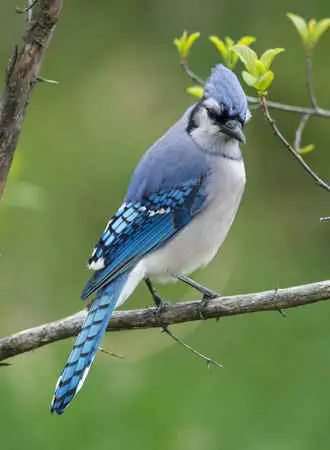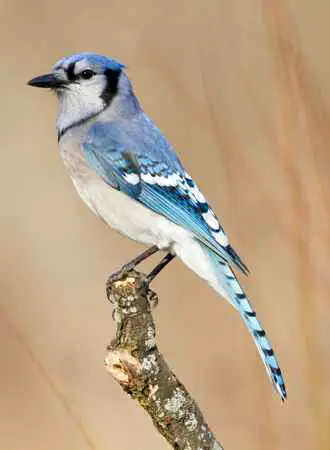Blue jays are known for their striking blue plumage, but these birds are also interesting for their social behavior.
Blue jays form monogamous pairs and mate for life. Throughout the year, mated pairs will give each other gifts, such as food or nesting material.
The blue jay pair will build the nest and rear the young, though only the female broods them. The male feeds the female while she is brooding the eggs.
This behavior ensures that both parents are invested in the survival of their offspring. As a result, blue jay couples have one of the highest rates of nesting success among songbirds.
How Often Do Blue Jays Reproduce?
A female blue jay can have up to two broods per year, with an average of 3-7 eggs per brood. Generally, blue jays of the north may raise one brood per breeding season while those in the south may produce two broods annually.

When Do Blue Jays Lay Eggs?
Female blue jays typically lay their eggs in early spring, but the exact timing can vary depending on the region. In some areas, blue jays lay eggs starting in early March, while in other parts of the country, they may not begin until April or May.
The peak season usually runs from late April to late May. The eggs appear light blue with tinges of green.
How Long Are Blue Jay Eggs Incubated?
Blue jays are incubating their eggs for about 16-18 days. The female will sit on the nest almost all day, only leaving to eat, drink and stretch her wings. The males are responsible for providing food while the females are on the nest.
During the last few days of the incubation period, the female will spend more time off the nest as the eggs start to hatch.
Once the egg hatches into a baby blue jay, it is altricial. This means the baby bird is born blind and naked. The parents will feed them and help them to learn how to fly and hunt for food.

How Many Eggs Do Blue Jays Lay?
These majestic birds typically have three to seven chicks in a clutch.
What’s the Difference Between a Male and a Female Blue Jay?
The blue jay is a strikingly beautiful bird that is native to North America. The blue feathers on the heads and backs of these birds are dazzlingly radiant. The bellies and chins of these birds are greyish white.
Both male and female birds look identical, with bright blue feathers and a crest on their head. The main difference between both sexes is their size, where males are slightly larger than females. Even so, this difference is barely distinguishable.
Another way to tell male from female birds apart is to observe their behavior. You can distinguish males from females by seeing which birds court the other birds. Males try to impress the females with their singing and behavior. The female blue jay does the incubating more than the male.

How do Blue Jays Choose Mates?
Most bird species have complex courtship and mating habits.
These colorful birds mate over two processes. The first process is the elimination, where the birds decide who will mate with whom. The second process is the consummation, where the birds actually mate.
Here’s how the mating ritual usually goes down:
Blue jays form a courtship group of 6 to 10 males who compete for the attention of a female. This is similar to how the reality show like “The Bachelorette” begin, with one male contestant after another volunteering to find love.
When the male birds surround the one female blue jay, the female flies to a nearby tree. All the males follow her while making a cacophony of blue jay calls.
Then the male blue jays in the courtship group will take turns making high whistling sounds, bobbing their heads up and down until one male taps out.
The male does this through self-assessment where he thinks he can’t compete with other males. They will continue the entire process until one bird remains.
After courtship, the blue jay couple goes off by themselves to form a pair bond for life. The pair will touch each other’s feathers and offer gifts of food or nesting items to each other. It’s not a red rose, but this is their way of showing their love for each other.
The Bottom Line on Do Blue Jays Mate for Life
Yes, blue jays mate for life. Unlike house wrens which mates for a single nesting season, two blue jays often form a life-long special bond with each other. That’s why they’re known as true love birds. Most birds don’t mate for life.
This monogamous behavior makes them a great symbol of love and commitment, something we can all aspire to have in our own lives. So next time you see a blue jay couple, remember that they are a true symbol of love and fidelity.
FAQs on Blue Jays
Where Do Blue Jays Live?
Blue jays are natives of the Nearctic region. These birds are more common in the east of the Rocky Mountains and Southern Canada. Some populations of these birds may migrate, while others reside in Newfoundland, Canada.
These North American birds can be found breeding in both deciduous and coniferous forests. They are also common in residential areas.

When Do Blue Jays Reach Sexual Maturity?
Young birds will become sexually mature within the first year of their life, at which time they begin looking for a mate to nest with.
How Long Do Blue Jays Live?
The oldest blue jay ever recorded lived 26 years. In the wild, blue jays have an average lifespan of up to 7 years. But in captivity where there are no predators, these birds live for much longer.
Do Blue Jays Nest in the Same Place Every Year?
It is more common for a pair of jays to build a new nest each breeding season. However, they sometimes reuse old nests. They may do so for multiple years in a row if the nest is in a secure and convenient location.






